Group Consensus with a Dynamic Leader for Multiagent Systems via Sampled-Data Control
Abstract
This paper considers a group consensus problem with a dynamic leader for multiagent systems in a sampled-data setting. With the leader’s state available to only a fraction of the followers, a distributed linear protocol based on sampled-data control is proposed for group consensus under fixed directed topology. On basis of M-matrix theory, we derive a sufficient condition on the sampling period and the control parameter for ultimate boundedness of the tracking errors. Furthermore, simulation examples are provided to demonstrate the effectiveness of the theoretical results.
1. Introduction
Over the past few decades, cooperative control and distributed coordination of multiagent systems have attracted increasing attention from many different disciplines, such as mathematics, physics, biology, sociology, and engineering science [1–9]. As a type of critical problems for cooperative control of multiple agents, consensus problem has been an active area of research. In [2], Jadbabaie et al. investigated the consensus of the linearized Vicsek model; they demonstrated that a simple neighbor rule makes all agents eventually move in the same direction under a joint connection condition. Olfati-Saber and Murray [3] established a systematical framework of a consensus problem in continuous-time multiagent systems with fixed and switching topology and communication time-delays. Following this line, numerous results have been reported on consensus of multiagent systems. For details, please refer to [10–13] and the references therein.
A particularly interesting topic is the leader-following consensus problem, whose objective is that the followers track a leader with local interaction. The leader-following consensus problem has been studied from different perspectives (see, e.g., [14–21]). In [14], the authors considered tracking control for first-order consensus with an active leader and gave a local controller together with a neighbor-based state-estimation rule. They further extended the results to the case of second-order consensus in [15]. In addition, Ren explored the consensus problem of multiagent systems with respect to a time-varying leader in [16]. In [17], Ren further studied leader-following consensus problem with, respectively, bounded control effort and directed switching interaction topologies. For multiagent systems with multiple leaders, Shi et al. investigated distributed tracking of a convex set specified by multiple leaders with unmeasurable velocities in [18]. It is worth pointing out that the information transmission among all the agents is continuous in [14–21].
In reality, it might be quite difficult or expensive to ensure the continuity of information exchange between agents due to the unreliability of information channels, the finite capability of transmission bandwidth of networks, the limited sensing ability, and the constraints of cost. Thus, sampled-data control for multiagent systems is more coincident with applications. For example, the authors proposed a proportional and derivative like (PD-like) protocol for multiagent systems with a time-varying reference state in [22]. Also, they studied convergence of two distributed sampled-data coordination protocols for double-integrator dynamics under fixed topology in [23]. Furthermore, convergence analyses of two distributed sampled-data coordination algorithms under directed switching topology were addressed in [24]. More results on sampled-data control for multiagent systems can be found in [25, 26].
In contrast to the consensus problems studied in the aforementioned results, group consensus [27, 28] or cluster consensus [29] concerns a multiagent system which is divided into multiple groups, and information exchange exists not only two agents in a group but also in different groups. It aims to design appropriate protocols or algorithms such that agents in a multiagent system reach more than one consistent state, that is, to find some appropriate control inputs such that consensus can be achieved in each group. In fact, group consensus or cluster consensus is a more general concept in comparison with traditional consensus. Moreover, it is suitable for some practical applications because of the complexities of lots of applicable multiagents systems. The authors solved a group average-consensus problem for networks with fixed topologies in [27] and further addressed group consensus in distributed multiagent systems with switching topologies and communication delays in [28]. Moreover, sufficient conditions for group consensus in directed networks were obtained in [29].
Note that the group consensus or cluster consensus problems investigated in [27–29] were all for continuous-time multiagent systems, and they were also leaderless consensus problems. Although group consensus without a leader is useful in many cases, there are many other applications that require a dynamic leader. A common example is formation control, where the followers regulate their states according to their state deviations and attain the expected formation. Inspired by the analysis above, we investigate the group consensus problem with a dynamic leader via sampled-data control. According to specific requirements, the agents in the system are divided into the desired groups, and each group converges to a state which has an expected deviation from that of the leader. By utilizing M-matrix theory, we consider the case where the state of leader is available to only a subset of followers. We first give a protocol for continuous-time multiagent systems; then for more realistic applications, we propose a group consensus protocol based on sampled-data control and analyze the convergence of the protocol. Consequently, we obtain the condition on the sampling period and the control parameter to ensure that the tracking errors are ultimately bounded.
2. Preliminaries
2.1. Graph and M-Matrix Theory
For a given matrix , det(A) denotes its determinant, ∥A∥∞ represents its maximum row sum norm, σ(A) is the set of all eigenvalues of A, and ρ(A) denotes its spectral radius. A matrix A is said to be positive stable if all of its eigenvalues have positive real parts, and it is Hurwitz stable (in the continuous-time sense) if all of its eigenvalues have negative real parts, while it is Schur stable (in the discrete-time sense) if all of its eigenvalues have magnitude less than 1. A = (aij) n×n is called a nonnegative matrix if aij ≥ 0, i, j = 1, …, n. is an n × n identity matrix and is an n × n zero matrix, and . ∥x∥∞ denotes the max norm of a vector . i is the imaginary unit. Given a complex number , and |μ| are its real part, imaginary part, and modulus, respectively.
A directed graph consists of a vertex set , an edge set . An edge (i, j) in a weighted directed graph denotes that agent i can access the state information of agent j but not necessarily vice versa. The index set of neighbors of node i is denoted by . The weighted adjacency matrix of graph is denoted by , where aij > 0 if and aij = 0 otherwise. Moreover, we assume aii = 0 for all . Let the Laplacian matrix associated with A be defined as and lij = −aij. It is straightforward to verify that L has at least one zero eigenvalue with a corresponding eigenvector 1n. A directed path is a sequence of edges in a directed graph of the form (i1, i2), (i2, i3), …, where . If there exists a path from node i to node j, we say that j is reachable from i.
If each agent is regarded as a vertex, then the interaction topology associated with the agents is conveniently described by a directed graph . In fact, includes n followers (related to graph ) and one leader (labeled as vertex 0) with directed edges from some vertices to vertex 0. The leader adjacency matrix associated with graph is defined as a matrix B = diag{b1, …, bn}, where bi > 0 if vertex 0 is a neighbor of the vertex i and bi = 0 otherwise. For , if there is a path in from every vertex i in to vertex 0, we say that vertex 0 is globally reachable in . For convenience, we define P = (pij) n×n = L + B with being the ith diagonal element of the matrix P, and .
M-matrix is an important and special class of matrix, which arises in many areas of application. Some definitions and lemmas concerning M-matrix are recalled in the following.
Definition 1 (see [30].)Let , where denotes the set of all n × n matrices with entries from . Then a matrix A = (aij) n×n is called an M-matrix if A ∈ Zn and A is positive stable.
Lemma 2 (see [31].)If A = (aij) n×n ∈ Zn, the following statements are equivalent:
- (i)
A is positive stable; that is, A is an M-matrix;
- (ii)
A is nonsingular and A−1 is a nonnegative matrix;
- (iii)
The diagonal entries of A are positive, and ρ(B) < 1, where B = In − X−1A, X = diag{a11, a22, …, ann}.
Lemma 3 (see [26].)P = L + B is an M-matrix if and only if the vertex 0 is globally reachable in .
The following lemmas will be useful in the analysis of the convergence of the sampled-data protocol.
Lemma 4 (see [30].)If ρ(A) < 1, , then the series I + A + A2 + ⋯ converges to the sum (In − A) −1.
Lemma 5 (Schur′s formula [32]). Let and . Then det (M) = det (AD − BC), if A, B, C and D commute pairwise.
Lemma 6 (see [33].)Given a complex-coefficient polynomial
2.2. Model Description
Consider a system consisting of n followers and one leader, where the n followers are separated into m (m ≤ n) groups. Let Eq, q = 1,2, …, m be the set of all the followers in the qth group. Our objective is to design suitable protocol or algorithm to realize group consensus, in the presence of information exchanges between followers of different groups.
Definition 7. Group consensus with a leader is said to be achieved asymptotically if the states of followers satisfy limt→∞∥xi(t) − x0(t) − ωq(t)∥ = 0, where x0(t) is the state of the leader and ωq(t) denotes the desired deviation between the leader and the followers in the qth group for q = 1,2, …, m.
Different from [27–29], we introduce a leader in the group consensus problem of this paper, and the followers in the network can be divided into several groups upon specific request. Furthermore, the followers in a group converge to a state which has an expected relative deviation from the state of the leader.
3. Sampled-Data Group Consensus with a Dynamic Leader
3.1. Sampled-Data Group Consensus Protocol
Lemma 8. Protocol (4) solves a group consensus problem asymptotically if and only if the vertex 0 is globally reachable in .
Proof. Noticing that P is an M-matrix, it follows from part (iii) of Lemma 2 that pii > 0, which implies that protocol (4) is well defined. Let , where , i ∈ Eq, q = 1,2, …, m. Then using the fact that , protocol (4) can be written as
Remark 9. Note that ui(t), i = 1,2, …, n, in (4) depends not only on the information states of its neighbors but also on their derivatives. In the special case that ωq(t) ≡ 0, for q = 1,2, …, m, protocol (4) is equivalent to protocol (3.4) in [10].
3.2. Convergence Analysis of the Sampled-Data Protocol
Lemma 10. Suppose that vertex 0 is globally reachable in ;
- (i)
then ρ(In − D−1P) < 1, where P = L + B, L and B are the Laplacian matrix and the leader adjacency matrix of graph , respectively, and D = diag{p11, p22, …, pnn};
- (ii)
let μj = ξj + iηj, j = 1,2, …, n, be the jth eigenvalue of D−1P, where ξj = Re (μj), ηj = Im (μj); then
()
holds;
- (iii)
ρ(H) < 1 if and only if the control parameter α and sampling period T satisfy
()
Proof. When vertex 0 is globally reachable in , it follows, from Lemma 3, that the matrix P = L + B is an M-matrix. Then according to Lemma 2, ρ(In − D−1P) < 1 holds.
To show part (ii), note that D−1P ∈ Zn and (D−1P) −1 = P−1D is nonnegative. Thus, by Lemma 2, D−1P is an M-matrix, which implies that D−1P is positive stable; that is, ξj > 0. Consequently, and . On the other hand, it follows from part (i) that ρ(In − D−1P) < 1. Equally, |1 − μj | < 1 for ∀μj ∈ σ(D−1P). Then, by some manipulation, we can obtain that . As a result, λj > 0 holds.
For the part (iii), let y be an eigenvalue of H; then the characteristic polynomial of H is given by
Remark 11. In [11], Ren has proved that ρ(D−1A) < 1 if the leader has directed paths to all followers in (Lemma 8.1 in [11]). Note that D−1A = D−1(D − P) = In − D−1P. Therefore, part (i) of Lemma 10 can be regarded as a simple proof of it using M-matrix theory.
Based on Lemma 10, we now present the main result.
Theorem 12. Suppose that vertex 0 is globally reachable in and there exist positive constants l1, l2 such that |x0[k] − x0[k − 1]| ≤ l1T and |ωq[k] − ωq[k − 1]| ≤ l2T, q = 1,2, …, m, If control parameter α and the sampling period T satisfy (26); then with the sampled-data protocol (9), group consensus can be achieved. In addition,
Proof. Since |x0[k] − x0[k − 1]| ≤ l1T and |ωq[k] − ωq[k − 1]| ≤ l2T for all k, we have that |gi[j]| = |2(x0[j] + ωq[j]) − x0[j − 1] − ωq[j − 1]−x0[j + 1] − ωq[j + 1]| ≤ 2(l1 + l2)T, i ∈ Eq, q = 1,2, …, m. Therefore, . It then follows from (16) that
4. Numerical Simulations
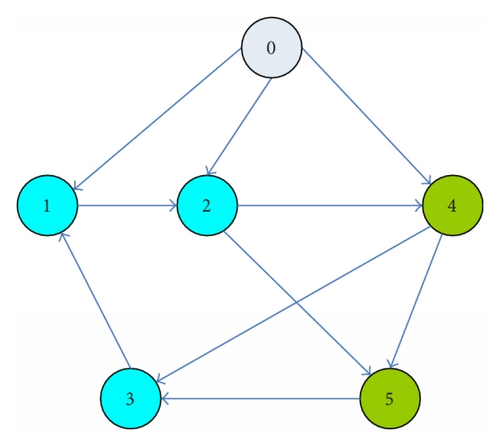
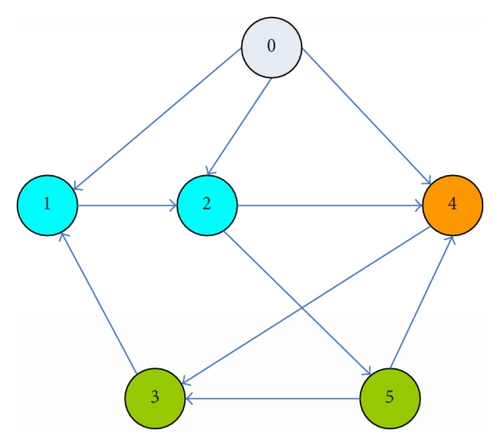
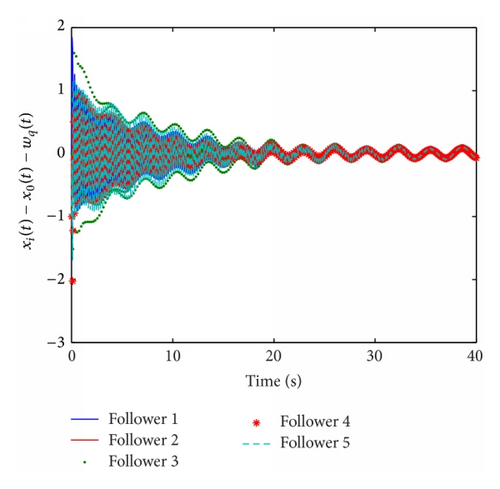
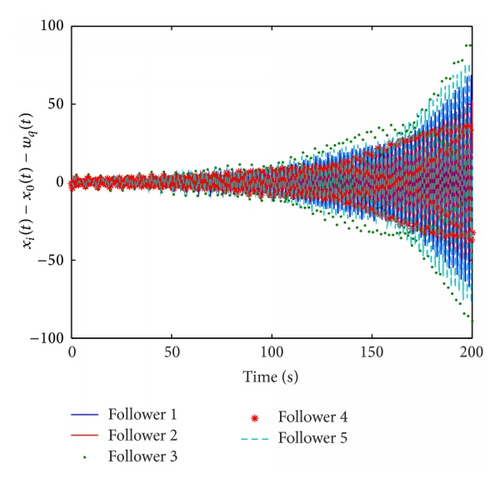
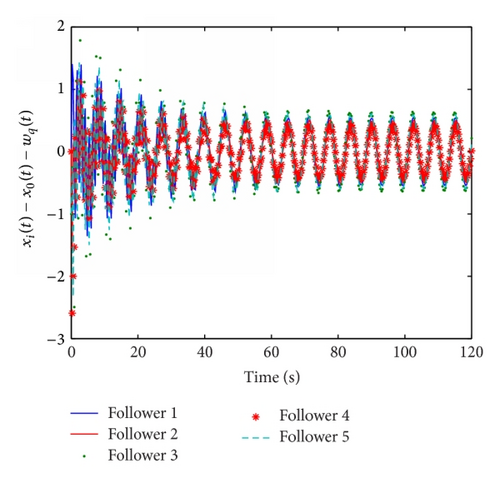
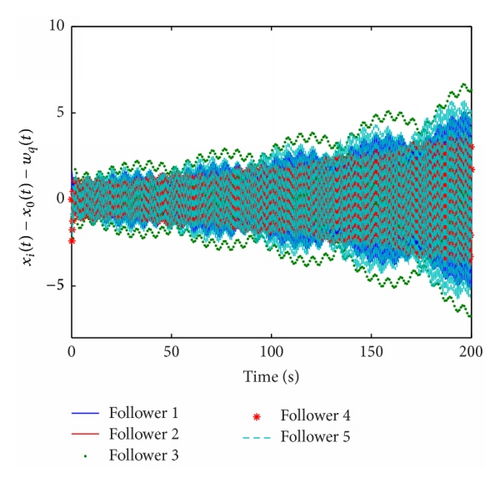
For the continuous-time protocol (4), assume that all the agents move on a plane, namely, k = 2. Consider the interaction topology depicted in Figure 4; note that , , and have indeed the same interaction topologies but different groups. The five followers in Figure 4 are divided into five groups; that is, m = 5 and Eq = {q}, q = 1,2, …, 5. Taking x0(t) = (t, 0) T and ωq(t) = (cos(πt/30 + 2qπ/5), sin(πt/30 + 2qπ/5)) T, q = 1,2, …, 5, Figure 5 shows the trajectories of agents, where the initial positions of agents are randomly generated in a given bounded region. It can be seen that the five followers converge to different states; specially, the lines connecting them form a pentagon.
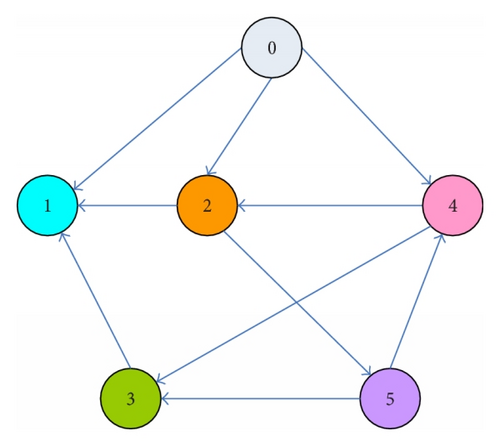
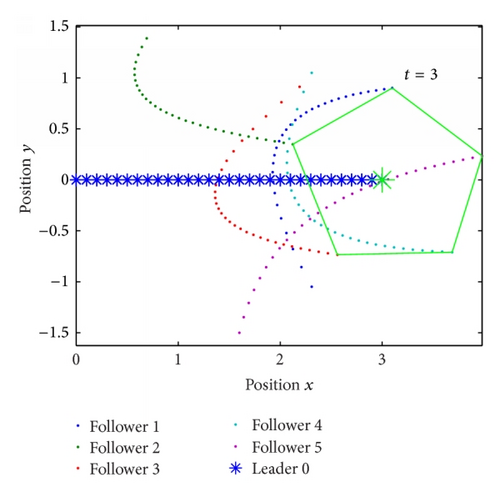
5. Conclusion
In this paper, the group consensus problem with a dynamic leader for multiagent systems in a sampled-data setting is investigated. We propose a distributed coordination protocol based on sampled-data control, in which only a subset of the followers has access to the state of leader. Then, by utilizing M-matrix theory, we present the convergence analysis of the protocol. The condition on the sampling period and the control parameter is presented to ensure convergence, and quantitative bounds of the tracking errors are given. Finally, numerical simulations are performed to validate the theoretical results. Our future work will focus on investigating group consensus problem with a leader under a directed switching communication graph.
Conflict of Interests
The authors declare that there is no conflict of interests regarding the publication of this paper.
Acknowledgments
This research is supported by NSFC (61104141, 61370147, 61170309, and 61301052), Chinese Universities Specialized Research Fund for the Doctoral Program (20110185110020), NSFC Tianyuan foundation (11126104), and the Fundamental Research Funds for the Central Universities (ZYGX2010J106).




